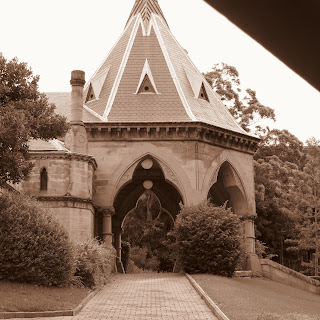Carter’s Barracks - Sandhillls / Devonshire Street Cemetary - Devonshire Street - Surry Hills - Sydney - New South Wales
Carter's Barracks Around 1901 - Picture Taken Before The Building Was Demolished To make way for Central Station to be built.
Carters Barracks, also known as Carter's Barracks, was a historic building complex located near the Devonshire Street Cemetery in Sydney, New South Wales, Australia. Here's some information about Carters Barracks:
1. Location: Carters Barracks was situated on the eastern side of Elizabeth Street, near the Devonshire Street Cemetery. The cemetery itself was located in what is now the area known as Central Station.
2. Purpose: Carters Barracks was initially constructed as military barracks during the early years of the colony. It was built to house convicts who were working on government projects, such as road construction and building projects in the city.
3. Construction and Design: The barracks were constructed in the Georgian architectural style. The building complex consisted of multiple single-story sandstone structures arranged around a central courtyard. It had a simple and utilitarian design.
4. Function: Over the years, the purpose of Carters Barracks evolved. In addition to housing convicts, it served various other functions. It was used as a hospital, a quarantine station, a female immigration depot, and even a factory for convict women.
5. Historical Significance: Carters Barracks is significant because it provides insights into the early colonial history of Sydney and the role of convicts in the development of the city. It reflects the harsh conditions and challenges faced by convicts and the changing functions of buildings over time.
6. Demolition: Unfortunately, Carters Barracks no longer exists today. The buildings were demolished in the early 20th century as part of urban development and city planning. The Devonshire Street Cemetery, which was adjacent to the barracks, was also relocated to make way for the construction of Sydney's Central Station.
While Carters Barracks no longer stands, its historical significance and connection to the colonial period in Sydney remain notable. The site serves as a reminder of the convict era and the development of the city during that time.
Carter's Barracks, also known as Carter's Male Orphan School Barracks, was a significant historical site located in Sydney, Australia. It served various purposes throughout its history, including housing, education, and military use. Here's an overview of its history:
Establishment and Purpose:
- Carter's Barracks was built in the early 19th century, with construction completed in 1819.
- It was initially established as the Male Orphan School to provide shelter, education, and training for orphaned and destitute boys in the colony.
Orphan School:
- The Male Orphan School aimed to provide basic education and teach practical skills to the boys in its care.
- Boys who attended the school came from a range of backgrounds, including orphans, abandoned children, and those from disadvantaged families.
Military Use:
- In the 1840s, the site was repurposed as a military barracks and named Carter's Barracks after Captain Edward Carter, who had served in the colony's military forces.
- The barracks accommodated soldiers and military personnel stationed in Sydney.
Changes and Closure:
- In the late 19th century, as the military's requirements changed, Carter's Barracks was no longer needed as a military facility.
- The barracks were eventually closed, and the site was repurposed for other uses.
Later Uses:
- After its military use, the barracks were converted into a government storage facility and later a government printing office.
- The site's historical significance as the Male Orphan School was recognized, and efforts were made to preserve its heritage value.
Heritage Status and Preservation:
- The remaining structures of Carter's Barracks were recognized as heritage-listed buildings due to their historical importance.
- The site showcases architectural features from different periods of its history, reflecting its evolving use over time.
Transformation into Hyde Park Barracks Museum:
- One of the buildings of Carter's Barracks was repurposed and adapted to house the Hyde Park Barracks Museum.
- The museum focuses on the history of convicts and immigration in colonial New South Wales and serves as a key historical site in Sydney.
Today, while Carter's Barracks no longer stands as a standalone structure, its legacy lives on through its role in the history of the Male Orphan School and as part of the Hyde Park Barracks Museum. The site's transformations and historical significance offer insights into Sydney's colonial past, the care of orphaned children, and the evolving uses of heritage buildings.






































